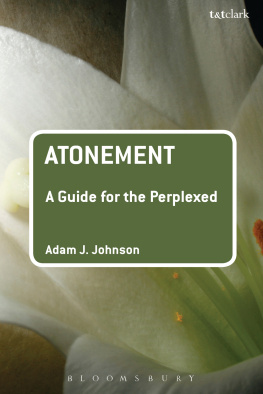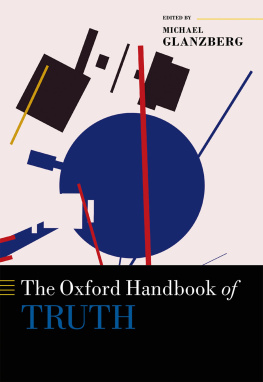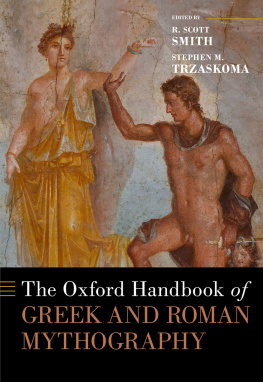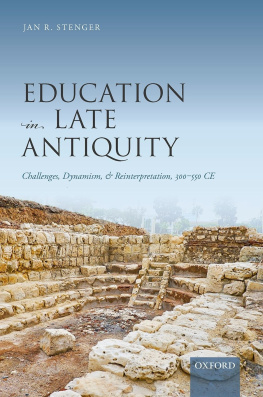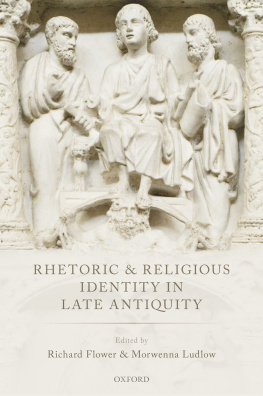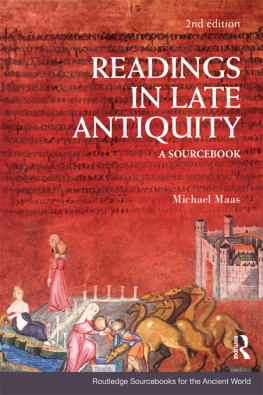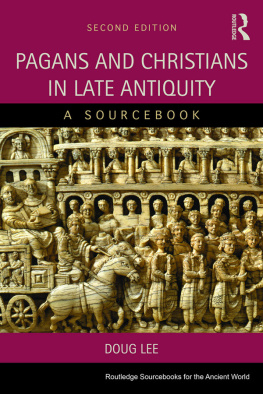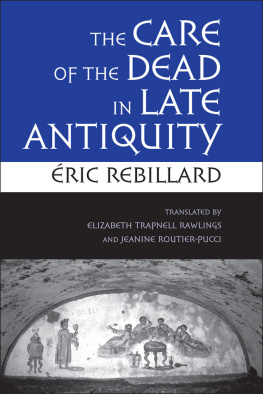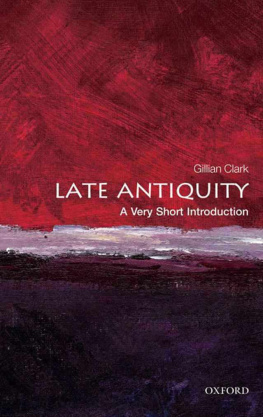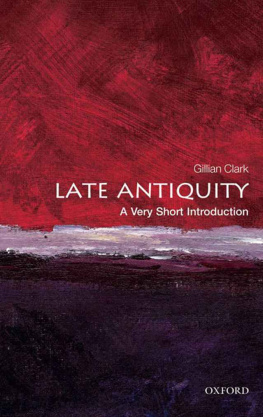Johnson - The Oxford handbook of late antiquity
Here you can read online Johnson - The Oxford handbook of late antiquity full text of the book (entire story) in english for free. Download pdf and epub, get meaning, cover and reviews about this ebook. year: 2016, publisher: Oxford University Press, genre: Art. Description of the work, (preface) as well as reviews are available. Best literature library LitArk.com created for fans of good reading and offers a wide selection of genres:
Romance novel
Science fiction
Adventure
Detective
Science
History
Home and family
Prose
Art
Politics
Computer
Non-fiction
Religion
Business
Children
Humor
Choose a favorite category and find really read worthwhile books. Enjoy immersion in the world of imagination, feel the emotions of the characters or learn something new for yourself, make an fascinating discovery.

- Book:The Oxford handbook of late antiquity
- Author:
- Publisher:Oxford University Press
- Genre:
- Year:2016
- Rating:4 / 5
- Favourites:Add to favourites
- Your mark:
- 80
- 1
- 2
- 3
- 4
- 5
The Oxford handbook of late antiquity: summary, description and annotation
We offer to read an annotation, description, summary or preface (depends on what the author of the book "The Oxford handbook of late antiquity" wrote himself). If you haven't found the necessary information about the book — write in the comments, we will try to find it.
The Oxford handbook of late antiquity — read online for free the complete book (whole text) full work
Below is the text of the book, divided by pages. System saving the place of the last page read, allows you to conveniently read the book "The Oxford handbook of late antiquity" online for free, without having to search again every time where you left off. Put a bookmark, and you can go to the page where you finished reading at any time.
Font size:
Interval:
Bookmark:
THE OXFORD HANDBOOK OF
LATE ANTIQUITY

THE OXFORD HANDBOOK OF
EDITED BY
SCOTT FITZGERALD JOHNSON


Oxford University Press is a department of the University of Oxford.
It furthers the Universitys objective of excellence in
research, scholarship, and education by publishing worldwide.
Oxford New York
Auckland Cape Town Dar es Salaam Hong Kong Karachi
Kuala Lumpur Madrid Melbourne Mexico City Nairobi
New Delhi Shanghai Taipei Toronto
With officies in
Argentina Austria Brazil Chile Czech Republic France Greece
Guatemala Hungary Italy Japan Poland Portugal Singapore
South Korea Switzerland Thailand Turkey Ukraine Vietnam
Oxford is a registered trademark of Oxford University Press in
the UK and certain other countries.
Published in the United States of America
by Oxford University Press
198 Madison Avenue, New York, NY 10016
Oxford University Press 2012
All rights reserved. No part of this publication may be reproduced,
stored in a retrieval system, or transmitted, in any form or by any means,
without the prior permission in writing of Oxford University Press, or as
expressly permitted by law, by license, or under terms agreed with the
appropriate reproduction rights organization. Inquiries concerning reproduction
outside the scope of the above should be sent to the Rights Department,
Oxford University Press, at the address above.
You must not circulate this work in any other form and you must impose this
same condition on any acquirer.
Library of Congress Cataloging-in-Publication Data
The Oxford handbook of late antiquity/edited by Scott Fitzgerald Johnson.
p. cm.
Includes bibliographical references and index.
ISBN 978-0-19-533693-1
1. Civilization, Greco-Roman. 2. Civilization, Medieval. 3. RomeCivilization.
4. Byzantine EmpireCivilization5271081.
I. Johnson, Scott Fitzgerald, 1976 II. Title: Oxford Handbook of Late Antiquity.
DE80.O84 2012
937dc23 2011018578
Frontispiece: The Barberini Ivory, depicting a sixth-century Roman emperor,
possibly Anastasius I or Justinian I (Runion des Muses Nationaux/Art Resource, NY).
1 3 5 7 9 8 6 4 2
Printed in the United State of America
on acid-free paper
To Averil Cameron and Peter Brown
Scott Fitzgerald Johnson, Georgetown University and Dumbarton Oaks
Herv Inglebert, Universit Paris Ouest NanterreLa Dfense (Paris X) (Translation from French prepared by Scott Fitzgerald Johnson)
Michael Kulikowski, Pennsylvania State University
Michael Maas, Rice University
Craig H. Caldwell III, Appalachian State University
Tim Greenwood, St. Andrews University
tienne de la Vaissire, cole des Hautes tudes en Sciences Sociales, Paris
Philip Wood, Sidney Sussex College, Cambridge University
Arietta Papaconstantinou, University of Reading
Anne Boudhors, Centre national de la recherche scientifique (CNRS) (Translation from French prepared by Arietta Papaconstantinou)
Christian Julien Robin, Centre national de la recherche scientifique (CNRS), member de l Institut (Translation from French prepared by Arietta Papaconstantinou)
Scott McGill, Rice University
Gianfranco Agosti, University of Rome La Sapienza
Brian Croke, Macquarie University and University of Sydney
Aaron P. Johnson, Lee University
Edward Watts, Indiana University
Samuel Rubenson, Lund University
Gregory Smith, Central Michigan University
Scott Fitzgerald Johnson, Georgetown University and Dumbarton Oaks
Jairus Banaji, School of Oriental and African Studies (SOAS)
Cam Grey, University of Pennsylvania
Kyle Harper, University of Oklahoma
Peregrine Horden, Royal Holloway, University of London
Ralph W. Mathisen, University of Illinois at Urbana-Champaign
Kevin Uhalde, Ohio University
Jill Harries, St. Andrews University
Andrew Gillett, Macquarie University
Jaclyn Maxwell, Ohio University
David M. Gwynn, Royal Holloway, University of London
Susan Wessel, Catholic University of America
Ann Marie Yasin, University of Southern California
Glenn Peers, University of Texas at Austin
Joel Walker, University of Washington
Robert Hoyland, Oriental Institute and St. Cross College, Oxford University
Stephen J. Shoemaker, University of Oregon
John Haldon, Princeton University
Petre Guran, Institute of South East European Studies, Bucharest
Christopher S. Celenza, Johns Hopkins University
SCOTT FITZGERALD JOHNSON
Georgetown University and Dumbarton Oaks
IN the year 845 C.E., in a monastery scriptorium in the northwest corner of Ireland, some 3,748 explanations of Latin grammatical points in the language of Old Irish were added by a pair of scribes to a precious manuscript of the Institutiones grammaticae (Elements of Latin Grammar) by the late antique scholar Priscian (Hofman 1996; Stokes and Strachan 1901). These represent some of the very first instances of an important vernacular tradition in Europe and testify to the vibrant intellectual culture of early medieval Ireland (; Law 1982). The Old Irish scribes were working in a far-flung corner of the former Roman worldreally just outside of what was the Roman world at its greatest extent. Their exemplar, Priscianus Caesariensis, had written his influential Latin grammar during the reign of the emperor Anastasius I (see frontispiece) in the Greek milieu of the sixth-century capital of Constantinople, three hundred years prior and half a world away (Averil Cameron 2009; Kaster 1988, no. 126). Constantinople and Ireland are two strange bedfellows, in the ancient world as much as today; yet such boundaries as existed were crisscrossed again and again during Late Antiquity, perhaps even more so at the end than at the beginning, despite the old Dark Ages chestnut. Clich or no, this story is one of intellectual transmission; that is, to quote a recent popular history (Cahill 1995), whether or not the Irish actually saved ancient civilization, these scribes were participating in it fully.
Half a century earlier than these Irish scribes, a different sort of real-world diglossia was put on display in central China. In 781 C.E., a large stele was set up, inscribed with both Chinese and Syriac inscriptions, to commemorate 150 years of East Syriac (aka Nestorian) Christian presence in the Tang capital of Xian (

Figure 0.1. Old Irish glosses on Priscians Institutiones grammaticae, 845 C.E. (St. Gallen, Stiftsbibliothek). See also color plate section.
Both the Old Irish Priscian glosses and the Nestorian Monument fall well outside the purview of Edward Gibbons Decline and Fall of the Roman Empire (17761788), the standard early-modern touchstone for students of Late Antiquity. Gibbon defined his subject (innovatively, including Byzantium) around the Mediterranean Sea and, specifically, around the portion of that world under the dominion of the Roman state. This statefrom the time of the emperor Constantine (307337) to the fall of Byzantium in 1453centered on the eastern imperial capital of Constantinople, the institutional successor to Augustus Rome, in the middle of an ever-shrinking and, in Gibbons view, ever-degenerating Byzantine empire. For Gibbon, the bulk of six volumes chronicling the long degeneration of the
Next pageFont size:
Interval:
Bookmark:
Similar books «The Oxford handbook of late antiquity»
Look at similar books to The Oxford handbook of late antiquity. We have selected literature similar in name and meaning in the hope of providing readers with more options to find new, interesting, not yet read works.
Discussion, reviews of the book The Oxford handbook of late antiquity and just readers' own opinions. Leave your comments, write what you think about the work, its meaning or the main characters. Specify what exactly you liked and what you didn't like, and why you think so.






